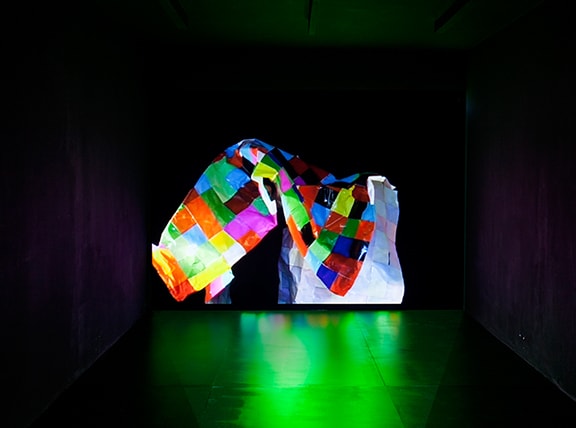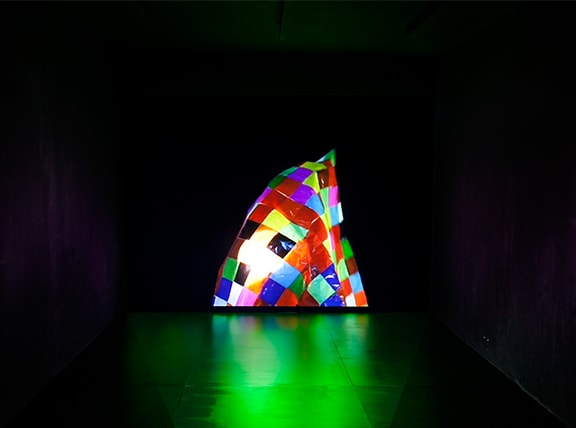exhibitions


STUDIO 12 | GABRIELLA MANGANO AND SILVANA MANGANO: NEON
–
Gabriella Mangano and Silvana Mangano: Studio Artists 2010 - 2011. To view their page click here.
GABRIELLA MANGANO and SILVANA MANGANO – Neon (2011)
Catalog text produced for Gertrude Contemporary and Art and Australia Emerging Writers Program -
Informally taped to the wall of Gabriella Mangano and Silvana Mangano’s studio was a small colour reproduction of Atsuko Tanaka’s Electric dress 1956. The page torn from a magazine suggested an intimate proximity to, and yet distance from, the Gutai artist’s work. In the conception and development of their single channel video Neon 2010, the Manganos’ thinking through the implications of Tanaka’s work is instructive: in the idea of the studio as stage; the inserting of the body into the work of art; the documentation of performance; the combining of performance and sculpture; the transformation of malleable materials; and the concealing and revealing of the inner life of a material subjectivity. This testing of language underpins the compelling spirit of Silvana and Gabriella’s work.
The videos of the Mangano’s have evolved out of a passion for drawing. The artists’ bodies are deployed to create a kind of drawing in space, aligned to the idea of automatic sketching, with the video camera a simple recording device. This mode of inquiry recalls the video work of Dutch artist Nan Hoover, who compared the making of video tapes
with drawing – ‘ the holding of a camera … like holding a pencil.’1 While there is a similar exploration through recording the movement of the body, the Mangano’s extend on Hoover’s singular proposition through their collaborative translation of gesture within the boundaries of space as a performance. Their intuitive response to each other becomes a silent conversation articulating an improvisation in progress with the same disciplined spontaneity as
rap sessions of street poets.
In Neon, however, Gabriella and Silvana are more intrigued with how an object may impose itself on their improvisation, moving away from their more direct and recurring use of the object as an instrument of drawing. The multi-coloured, checked-paper rectangle, which figures in Neon, could be many things – tablecloth, tarpaulin, tent, cloak, packaging – introducing a new potential to conceal and reveal their relationship with each other. Though still an active umbilical cord (an ongoing motif in Silvana and Gabriella’s work), this malleable form changes meaning during their performance, and with its transformation into a more sculptural object lends a new ambiguity to the dialogue.2
A problematic ambiguity exists between performance and its documentation: documentation undercuts the present-ness of performance, and at the same time extends the event, albeit as mediated and second degree. The spin on the idea of a document emerges when the work is defined as the outcome of the performance, rather than existing as a consciously produced record of the performance activity.
The relationship between performance and documentation is also always a question of time: here and now, there and then. Temporal duration is a motif of Neon: the deliberately understated video helps maintain the sense that the performance comprises no more and no less than what is presented. As one continual sequence, the viewer may enter, or leave, at any point; the performance implies a consciousness of simple on-going play.
Following their interest in the work of Gutai, Gabriella and Silvana construct their studio as a stage for the creation of their work, clearing a space within the everyday clutter to improvise their performance. The intimate space of the studio opens up a focus on play and process. Less concerned with outcomes, the video camera bears witness rather than informing the action, thereby allowing whatever the artists are doing to be the focus.
If recurring motifs are recognisable in all Silvana and Gabriella’s videos – the drawing of a line, the delineation of space between individuals and the symbiotic relationship of collaboration – Neon points to the Mangano’s taking a chance with their play, through a more loosely improvised unfolding of the event. Susan Stewart’s writings on art as an ‘alterative model of time’ draws out the role of chance in play:
… rules are set out at the start and specific to the emerging actions of the players; the end is a matter of consensus, an often arbitrary stopping point. If chance composition works like a game, composing while remaining open to chance works like play.’3
Neon shifts attention away from the presence of the artists onto the object in play through an intersection of material and camouflage, revealing another form of contingency through the transformation of malleable material. This substitution of variables speaks of the Mangano’s visceral interest in the life of the material rather than the object itself, suggesting new concerns underscoring their enigmatic imagination.
Improvisation may be rendered with intent in Neon; yet Gabriella and Silvana offer an insight into their poetic questioning; and at the same time, their absorbing awareness and open playfulness becomes an intangible experience for the viewer, with the option of play-back.
—
1 Marga van Mechelen, de Appel: performances installations video projects 1975-1983 (Amsterdam:
de Appel, 2006), pp. 280-281
2 Two examples of previous works are Absence of Evidence (2008) in which paper is passed between
the two artists on either side of a wall, and Between near and far (2008) where streamers are thrown
back and forth between the sisters.
3 Susan Stewart, The Open Studio (Chicago: University of Chicago Press 2005), p.12
SUSAN COHN